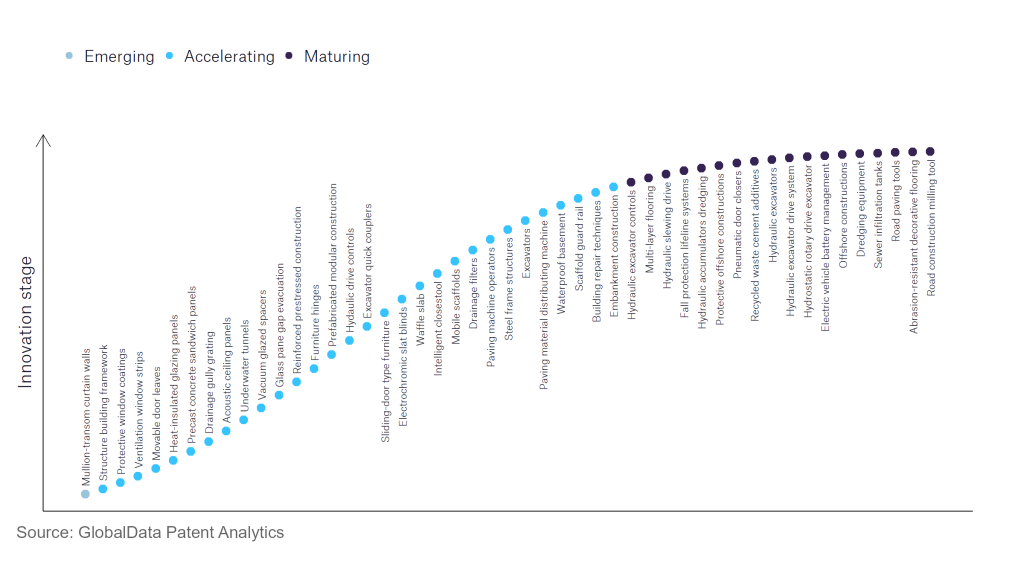The construction industry continues to be a hotbed of innovation, with activity driven by an increased focus on environmental sustainability and workplace safety, and the growing importance of technologies such as the Internet-of-Things (IoT) and robotics as well as higher quality construction products and materials. In the last three years alone, there have been over 248,000 patents filed and granted in the construction industry, according to GlobalData’s report on Innovation in Construction: Intelligent closestool. Buy the report here.
However, not all innovations are equal and nor do they follow a constant upward trend. Instead, their evolution takes the form of an S-shaped curve that reflects their typical lifecycle from early emergence to accelerating adoption, before finally stabilising and reaching maturity.
Identifying where a particular innovation is on this journey, especially those that are in the emerging and accelerating stages, is essential for understanding their current level of adoption and the likely future trajectory and impact they will have.
80+ innovations will shape the construction industry
According to GlobalData’s Technology Foresights, which plots the S-curve for the construction industry using innovation intensity models built on over 179,000 patents, there are 80+ innovation areas that will shape the future of the industry.
Within the emerging innovation stage, mullion-transom curtain walls is a disruptive technology that is in the early stages of application and should be tracked closely. Heat-insulated glazing panels, drainage gully grating, and acoustic ceiling panels are some of the accelerating innovation areas, where adoption has been steadily increasing. Among maturing innovation areas are abrasion-resistant decorative flooring and road construction milling tool, which are now well established in the industry.
Innovation S-curve for the construction industry

Intelligent closestool is a key innovation area in construction
An intelligent toilet, also known as a smart toilet or an intelligent closestool, is a type of toilet that incorporates advanced technology and features to enhance the user experience. Features can include automatic cleaning, flushing, heating and more.
GlobalData’s analysis also uncovers the companies at the forefront of each innovation area and assesses the potential reach and impact of their patenting activity across different applications and geographies. According to GlobalData, there are 20+ companies, spanning technology vendors, established construction companies, and up-and-coming start-ups engaged in the development and application of intelligent closestool.
Key players in intelligent closestool – a disruptive innovation in the construction industry
‘Application diversity’ measures the number of different applications identified for each relevant patent and broadly splits companies into either ‘niche’ or ‘diversified’ innovators.
‘Geographic reach’ refers to the number of different countries each relevant patent is registered in and reflects the breadth of geographic application intended, ranging from ‘global’ to ‘local’.
Patent volumes related to intelligent closestool
| Company | Total patents (2021 - 2023) | Premium intelligence on the world's largest companies |
| Toto | 110 | Unlock Company Profile |
| Kohler | 40 | Unlock Company Profile |
| LIXIL | 27 | Unlock Company Profile |
| Xiamen R&T Plumbing Technology | 26 | Unlock Company Profile |
| Guangdong Dongpeng Holdings | 24 | Unlock Company Profile |
| Allegion | 21 | Unlock Company Profile |
| Marriott International | 21 | Unlock Company Profile |
| Duravit | 19 | Unlock Company Profile |
| JOMOO Kitchen & Bath | 15 | Unlock Company Profile |
| Huida Sanitary Ware | 14 | Unlock Company Profile |
| Guangdong Hegii Sanitary Wares | 13 | Unlock Company Profile |
| Grifols | 12 | Unlock Company Profile |
| Masco | 12 | Unlock Company Profile |
| Jomoo Kitchen & Bath Appliances | 12 | Unlock Company Profile |
| Takayoshi | 11 | Unlock Company Profile |
| SACMI | 10 | Unlock Company Profile |
| Chongqing Concast Sanitary Ware | 10 | Unlock Company Profile |
| Xiamen Dabai Technology | 9 | Unlock Company Profile |
| Bolina Holding | 8 | Unlock Company Profile |
| SJM Holdings | 8 | Unlock Company Profile |
| Panasonic | 7 | Unlock Company Profile |
| Sichuan Aimbon Mold | 7 | Unlock Company Profile |
| Zhejiang Ikahe Sanitary Ware | 6 | Unlock Company Profile |
| Airbus | 5 | Unlock Company Profile |
| Xiamen Zhijie Intelligent Technology | 5 | Unlock Company Profile |
| Villeroy & Boch | 5 | Unlock Company Profile |
Source: GlobalData Patent Analytics
Toto is the leading filer in intelligent closestool manufacturing. The company is one of the world leaders in toilet manufacturing. Toto is widely known for making the Washlet, which uses automatic cleaning techniques and making the Warmlet, which warms the toilet seat. Toto's Neorest line of toilets include an integrated bidet, automatic flushing, automatic seat heating, and an automatic lid that opens and closes. They also have a UV light that automatically sanitises the toilet bowl after each use.
In terms of application diversity, SJM Holdings is among the leaders in the pack, along with Airbus. By means of geographic reach, Sika holds the top position, followed by Eternit NVC and CelluComp.
To further understand the key themes and technologies disrupting the construction industry, access GlobalData’s latest thematic research report on Construction.
Data Insights
From

The gold standard of business intelligence.
Blending expert knowledge with cutting-edge technology, GlobalData’s unrivalled proprietary data will enable you to decode what’s happening in your market. You can make better informed decisions and gain a future-proof advantage over your competitors.



